ECO mode JEEP CJ 1953 Owner's Guide
[x] Cancel search | Manufacturer: JEEP, Model Year: 1953, Model line: CJ, Model: JEEP CJ 1953Pages: 376, PDF Size: 19.96 MB
Page 260 of 376
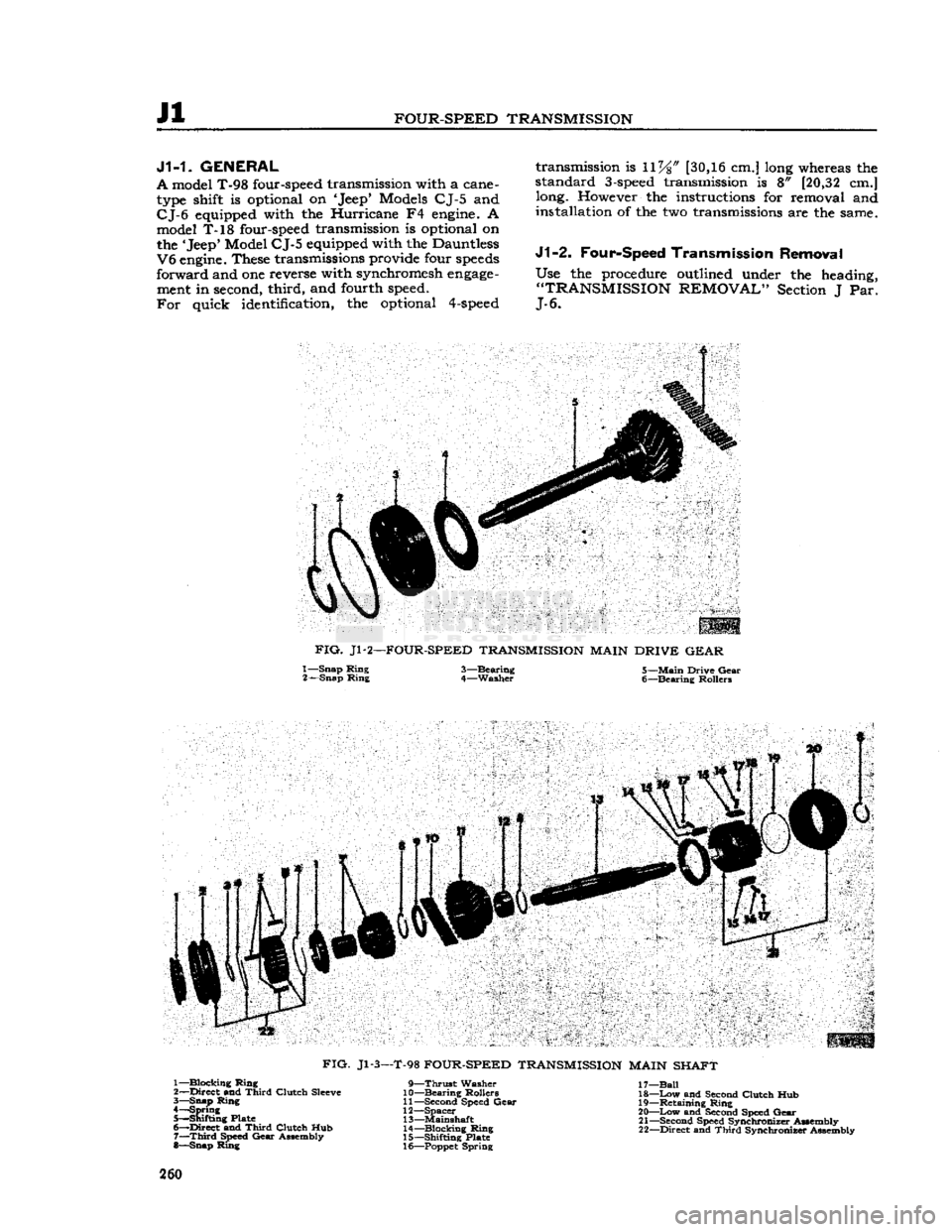
Jl
FOUR-SPEED
TRANSMISSION
J1-1.
GENERAL
A
model T-98 four-speed transmission with a cane- type shift is optional on 'Jeep* Models CJ-5 and
CJ-6
equipped with the Hurricane F4
engine.
A model T-18 four-speed transmission is optional on
the 'Jeep* Model
CJ-5
equipped with the Dauntless
V6
engine.
These transmissions provide four
speeds
forward
and one reverse with synchromesh
engage
ment in second,
third,
and fourth speed.
For
quick identification, the optional
4-speed
transmission is 11%"
[30,16
cm.] long whereas the
standard
3-speed
transmission is 8"
[20,32
cm.] long. However the instructions for removal and
installation of the two transmissions are the same.
J1-2.
Four-Speed
Transmission Removal Use the procedure outlined under the heading,
"TRANSMISSION
REMOVAL"
Section J Par.
J-6.
FIG.
Jl-2—FOUR-SPEED TRANSMISSION MAIN DRIVE
GEAR
1—
Snap
Ring
3—Bearing 5—Main
Drive
Gear
2—
Snap
Ring
4—Washer 6—Bearing Rollers
FIG.
Jl-3—T-98
FOUR-SPEED TRANSMISSION MAIN SHAFT 1—
Blocking
Ring
2—
Direct
and
Third
Clutch
Sleeve
3—
Snap
Ring
4—
Spring
5—
Shifting
Plate
6—
Direct
and
Third
Clutch
Hub 7—
Third
Speed
Gear
Assembly
8—
Snap
Ring
9—Thrust
Washer
10—
Bearing
Rollers
11—
Second Speed
Gear
12—
Spacer
13—
Mainshaft
14—
Blocking
Ring
15—
Shifting
Plate
16— Poppet
Spring
17—
Ball
18—
Low
and Second
Clutch
Hub 19—
Retaining
Ring
20—
Low
and Second Speed
Gear
21—
Second Speed
Synchronizer
Assembly
22—
Direct
and
Third
Synchroniser Assembly 260
Page 261 of 376
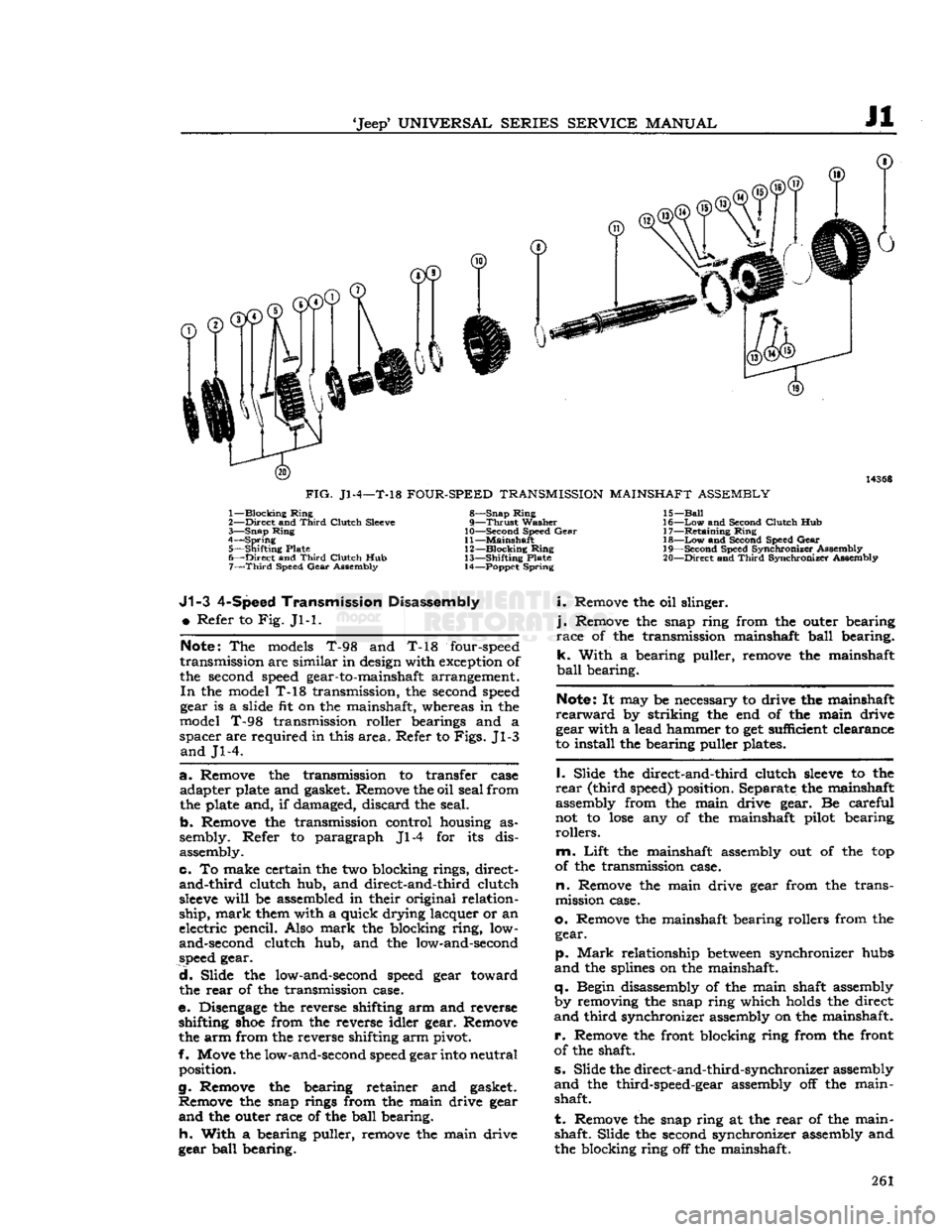
'Jeep*
UNIVERSAL
SERIES SERVICE
MANUAL
Jl
1—
Blocking
Rir
2—
Direct
and 1
3—
Snap
Ring
4—
Spring
5—
Shifting
Plat
6—
Direct
and 1 7—
Third
Speed
J1-3
4-Speed Transmission Disassembly
•
Refer to Fig. Jl-1.
Note;
The
models
T-98 and T-18 four-speed
transmission are similar in design with exception of
the second
speed
gear-to-mainshaft arrangement.
In
the model T-18 transmission, the second
speed
gear is a slide fit on the mainshaft, whereas in the
model T-98 transmission roller bearings and a
spacer are required in this area. Refer to Figs. Jl-3
and
Jl-4.
a.
Remove the transmission to transfer case adapter plate and gasket. Remove the oil seal from
the plate and, if damaged, discard the seal.
b. Remove the transmission control housing as
sembly. Refer to paragraph Jl-4 for its dis
assembly.
c. To make certain the two blocking rings, direct-
and-third
clutch hub, and direct-and-third clutch
sleeve
will
be assembled in their original relation
ship,
mark them with a quick drying lacquer or an
electric pencil. Also mark the blocking ring, low-
and-second clutch hub, and the low-and-second
speed
gear.
d.
Slide the low-and-second
speed
gear toward the rear of the transmission case.
e.
Disengage
the reverse shifting arm and reverse shifting
shoe
from the reverse idler gear. Remove
the arm from the reverse shifting arm pivot.
f. Move the low-and-second
speed
gear
into
neutral position.
g. Remove the bearing retainer and gasket.
Remove the snap rings from the main drive gear
and
the outer race of the ball bearing.
h.
With a bearing puller, remove the main drive
gear ball bearing. 1436S
i
Hub
Gear
izer
Assembly
ironizer
Assembly
i.
Remove the oil slinger.
j.
Remove the snap ring from the outer bearing
race
of the transmission mainshaft ball bearing.
k. With a bearing puller, remove the mainshaft
ball
bearing.
Note:
It may be necessary to drive the mainshaft
rearward
by striking the end of the main drive gear with a lead hammer to get sufficient clearance
to install the bearing puller plates.
I.
Slide the direct-and-third clutch
sleeve
to the
rear
(third
speed)
position. Separate the mainshaft
assembly from the main drive gear. Be careful
not to
lose
any of the mainshaft pilot bearing
rollers.
m.
Lift
the mainshaft assembly out of the top
of the transmission case.
n.
Remove the main drive gear from the trans
mission case.
o. Remove the mainshaft bearing rollers from the gear.
p.
Mark
relationship
between
synchronizer hubs
and
the splines on the mainshaft.
q. Begin disassembly of the main shaft assembly by removing the snap ring which holds the direct
and
third synchronizer assembly on the mainshaft,
r.
Remove the front blocking ring from the front
of the shaft.
s. Slide the direct-and-third-synchronizer assembly
and
the third-speed-gear assembly off the main-shaft.
t. Remove the snap ring at the rear of the main-
shaft. Slide the second synchronizer assembly and the blocking ring off the mainshaft.
FIG.
Jl-4—T-18
FOUR-SPEED TRANSMISSION MAINSHAFT ASSEMBLY
ng 8—Snap
Ring
15—Ball
third
Clutch
Sleeve
9—Thrust
Washer 16—Low and Second
Clutch
10—
Second
Speed
Gear
17—Retaining
Ring
11—
Mainshaft
18—Low and Second Speed
te 12—Blocking
Ring
19—Second Speed
Synchroni
rhird
Clutch
Hub 13—Shifting Plate 20—Direct and
Third
Synch
Gear
Assembly 14—Poppet
Spring
261
Page 264 of 376
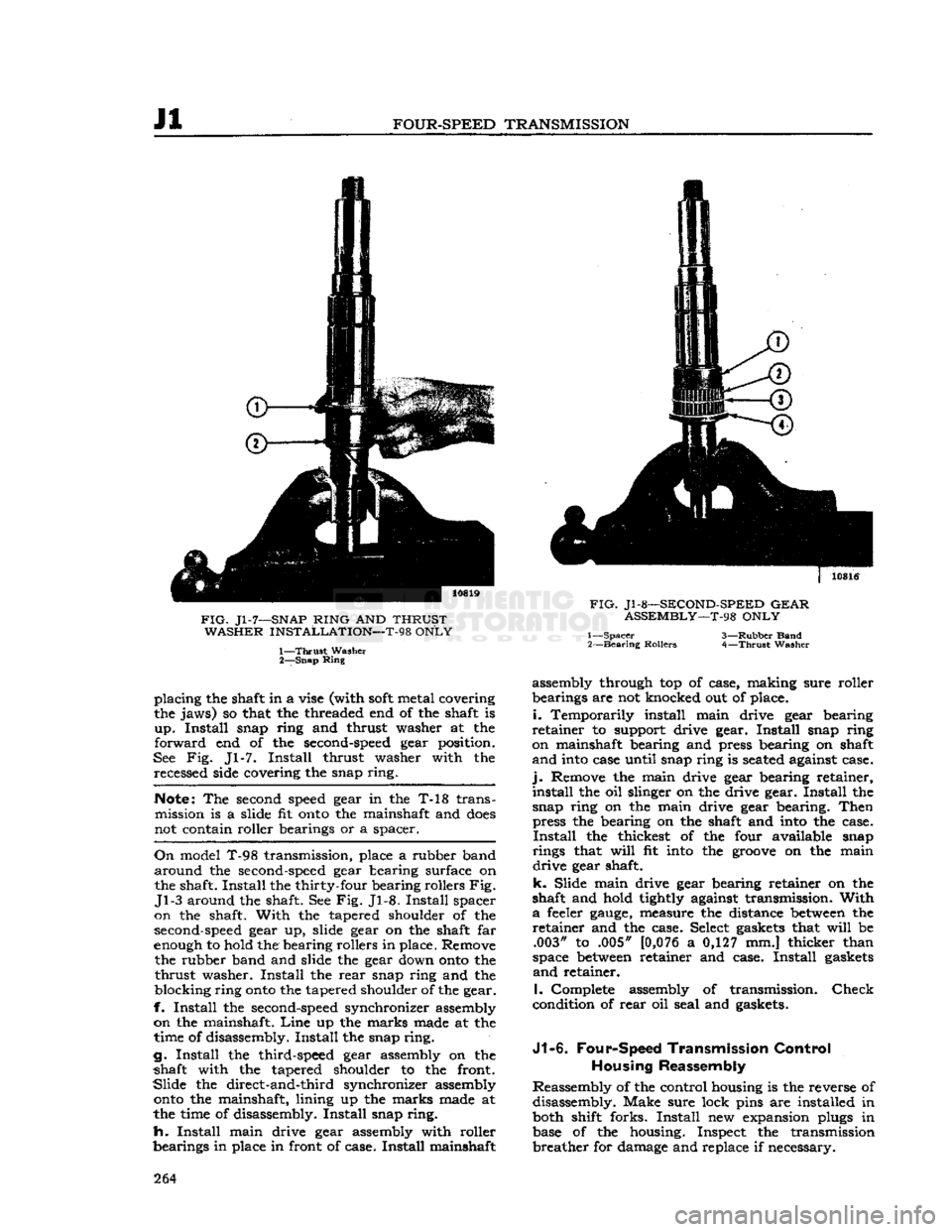
Jl
FOUR-SPEED TRANSMISSION
FIG.
Jl-7—SNAP
RING
AND
THRUST WASHER INSTALLATION—T-98 ONLY
1—
Thrust
Washer
2—
Snap
Ring
placing
the shaft in a vise (with
soft
metal covering the jaws) so that the threaded end of the shaft is
up.
Install
snap ring and thrust washer at the
forward
end of the
second-speed
gear position.
See Fig. Jl-7.
Install
thrust washer with the recessed side covering the snap
ring.
Note:
The second
speed
gear in the T-18 trans mission is a slide fit
onto
the mainshaft and
does
not contain roller bearings or a spacer.
On
model T-98 transmission, place a rubber band
around
the
second-speed
gear bearing surface on
the shaft.
Install
the thirty-four bearing rollers Fig.
Jl-3
around the shaft. See Fig. Jl-8.
Install
spacer on the shaft.
With
the tapered shoulder of the
second-speed
gear up, slide gear on the shaft far
enough
to hold the bearing rollers in place. Remove the rubber band and slide the gear down
onto
the
thrust
washer.
Install
the
rear
snap ring and the
blocking ring
onto
the tapered shoulder of the gear.
f.
Install
the
second-speed
synchronizer assembly
on the mainshaft.
Line
up the marks made at the
time of disassembly.
Install
the snap
ring.
g.
Install
the third-speed gear assembly on the
shaft with the tapered shoulder to the front.
Slide
the direct-and-third synchronizer assembly
onto
the mainshaft, lining up the marks made at
the time of disassembly.
Install
snap
ring.
h.
Install
main drive gear assembly with roller
bearings in place in front of case.
Install
mainshaft
FIG.
Jl-8—SECOND-SPEED
GEAR
ASSEMBLY—T-98 ONLY
1—
Spacer
3—Rubber
Band
2—
Bearing
Rollers
4—Thrust
Washer
assembly through top of case, making sure roller
bearings are not knocked out of place,
i.
Temporarily install main drive gear bearing
retainer
to support drive gear.
Install
snap ring on mainshaft bearing and press bearing on shaft
and
into case until snap ring is seated against case,
j-
Remove the main drive gear bearing retainer,
install
the oil slinger on the drive gear.
Install
the snap ring on the main drive gear bearing.
Then
press the bearing on the shaft and into the case.
Install
the thickest of the four available snap
rings that
will
fit into the
groove
on the main
drive
gear shaft.
k.
Slide main drive gear bearing retainer on the
shaft and hold tightly against transmission.
With
a
feeler
gauge,
measure the distance
between
the
retainer
and the case. Select gaskets that
will
be .003" to .005"
[0,076
a 0,127 mm.] thicker than
space
between
retainer and case.
Install
gaskets
and
retainer.
I.
Complete assembly of transmission.
Check
condition of
rear
oil seal and gaskets.
J1-6. Four-Speed
Transmission Control
Housing Reassembly
Reassembly of the control housing is the reverse of disassembly. Make sure lock pins are installed in
both shift forks.
Install
new expansion plugs in base of the housing. Inspect the transmission
breather
for damage and replace if necessary. 264
Page 266 of 376
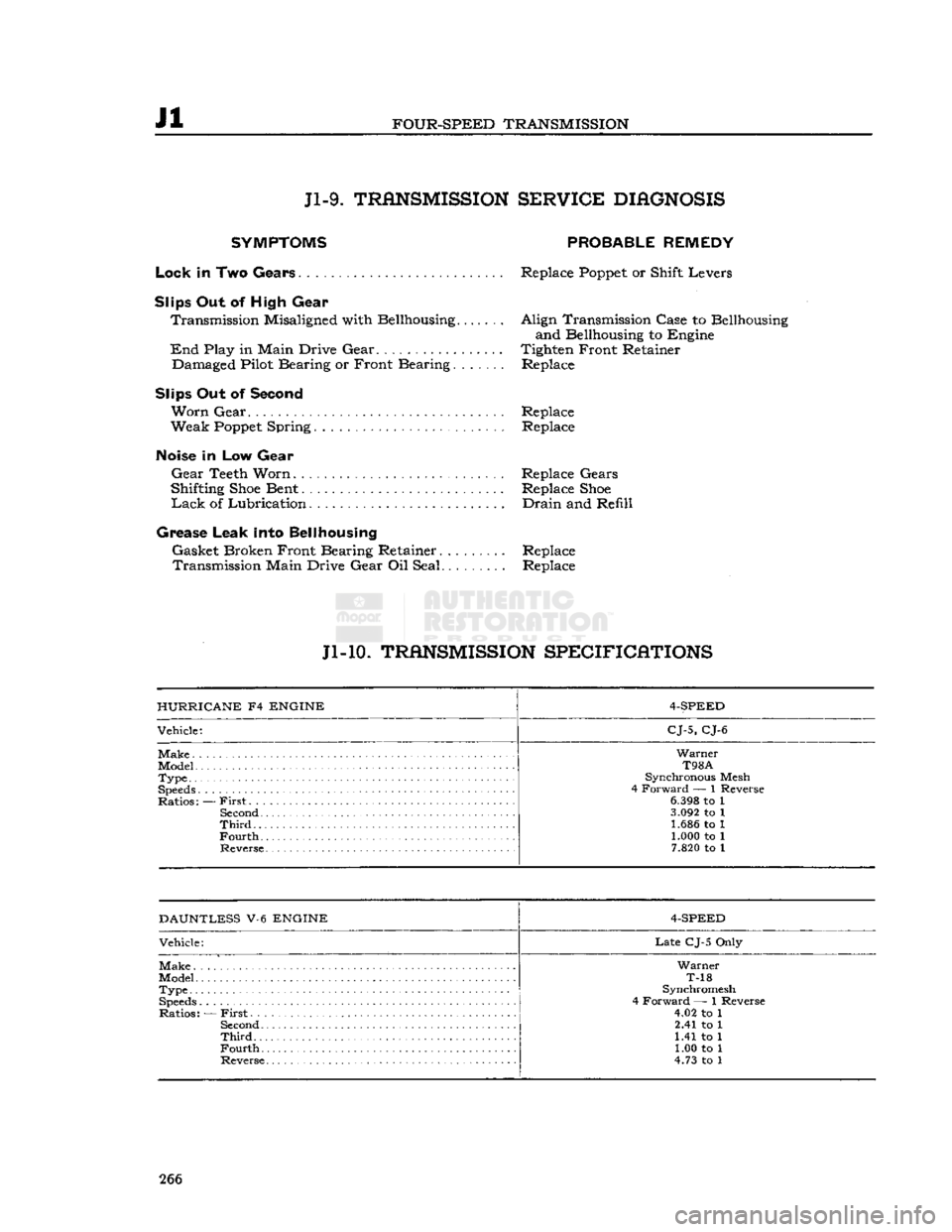
Jl
FOUR-SPEED
TRANSMISSION
Jl-9.
TRANSMISSION
SER¥ICE
DIAGNOSIS
SYMPTOMS
Lock
In Two Gears
Slips
Out of High Gear Transmission Misaligned with Bellhousing
End
Play in Main Drive Gear Damaged Pilot Bearing or Front Bearing.
Slips Out of
Second
Worn
Gear
Weak
Poppet
Spring
PROBABLE
REMEDY
Replace
Poppet
or Shift Levers
Align Transmission Case to Bellhousing and Bellhousing to Engine
Tighten Front Retainer Replace
Replace Replace
Noise
in Low Gear
Gear
Teeth Worn. Replace Gears
Shifting
Shoe
Bent Replace
Shoe
Lack
of Lubrication Drain and Refill
Grease
Leak into Bellhousing Gasket Broken Front Bearing Retainer......... Replace Transmission Main Drive Gear Oil Seal Replace
Jl-10.
TRANSMISSION
SPECIFICATIONS
HURRICANE
F4
ENGINE
4-SPEED
Vehicle:
CJ-5,
CJ-6
Warner
T98A
Type..
• Synchronous Mesh
4 Forward — 1 Reverse
Ratios: —
First
. .
6.398
to 1
Second
3.092
to 1
Third
1.686 to 1
Fourth
1.000 to 1
7.820
to 1
DAUNTLESS
V-6
ENGINE
4-SPEED
Vehicle:
Late
CJ-5 Only
Warner
Model T-18
Type Synchromesh
4 Forward — 1 Reverse
Ratios: —
First
4.02 to 1
Second
2.41 to 1
Third
1.41 to 1
Fourth
1.00 to 1
Reverse 4.73 to 1 266
Page 267 of 376
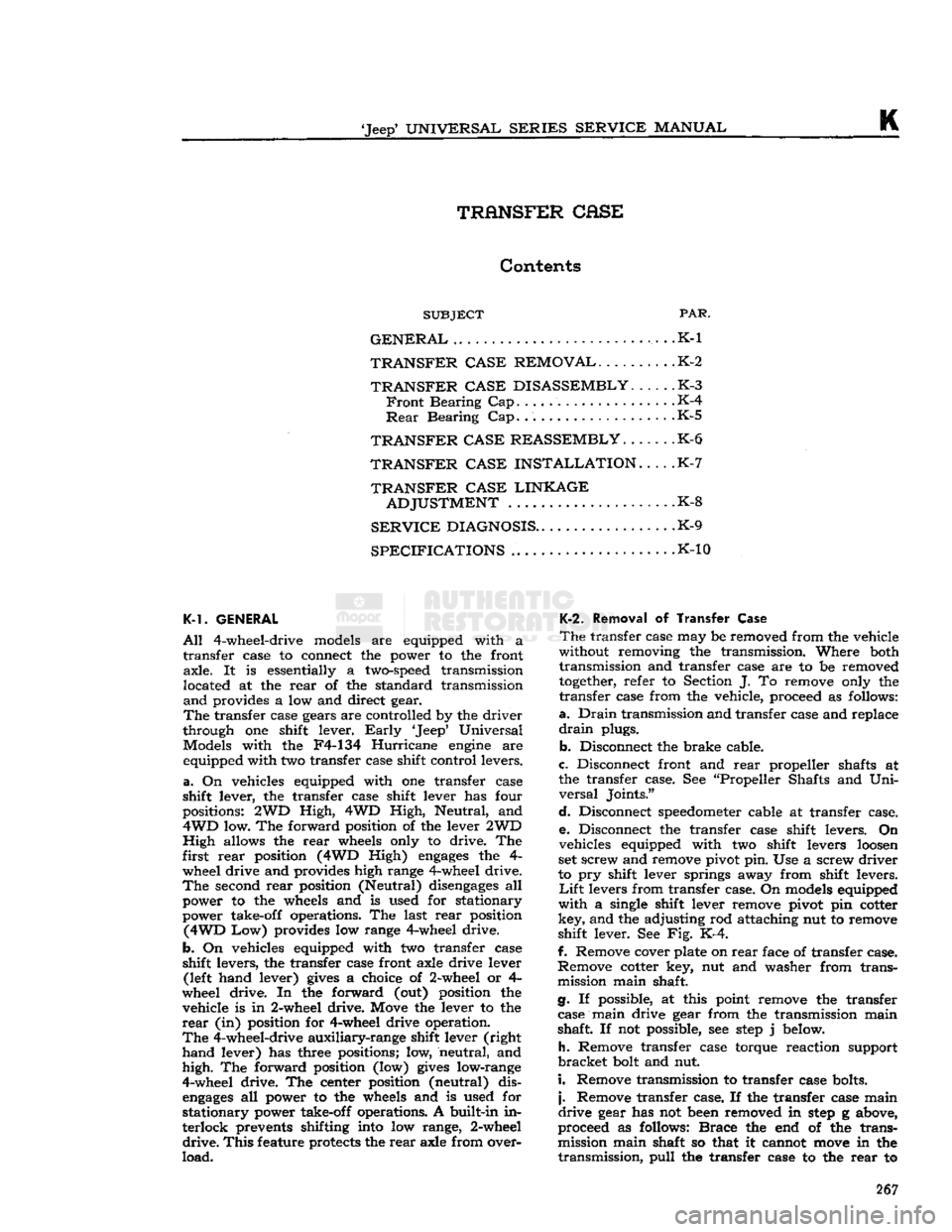
'Jeep'
UNIVERSAL SERIES SERVICE
MANUAL
ft
TRANSFER CASE
Contents
SUBJECT
PAR.
GENERAL
. . .K-1
TRANSFER CASE REMOVAL
K-2
TRANSFER CASE DISASSEMBLY
K-3
Front
Bearing Cap K-4
Rear
Bearing Cap K-5
TRANSFER CASE REASSEMBLY.
. .K-6
TRANSFER CASE INSTALLATION
K-7
TRANSFER CASE LINKAGE
ADJUSTMENT
K-8
SERVICE
DIAGNOSIS
K-9
SPECIFICATIONS
.K-10
K-1. GENERAL
All
4-wheel-drive models are equipped with a
transfer
case to connect the power to the front
axle.
It is essentially a
two-speed
transmission
located at the
rear
of the standard transmission
and
provides a low and direct gear.
The
transfer case gears are controlled by the
driver
through
one shift lever.
Early
'Jeep'
Universal
Models with the F4-134
Hurricane
engine
are equipped with two transfer case shift control levers.
a.
On vehicles equipped with one transfer case
shift
lever, the transfer case shift lever has four
positions: 2WD
High,
4WD
High,
Neutral, and
4WD
low. The forward position of the lever 2WD
High
allows the
rear
wheels only to drive. The
first
rear
position (4WD High)
engages
the 4- wheel drive and provides high range 4-wheel drive.
The
second
rear
position (Neutral)
disengages
all power to the wheels and is used for stationary
power take-off operations. The last
rear
position
(4WD
Low) provides low range 4-wheel drive.
b.
On vehicles equipped with two transfer case
shift
levers, the transfer case front axle drive lever (left hand lever)
gives
a choice of 2-wheel or 4-
wheel drive. In the forward (out) position the
vehicle is in 2-wheel drive. Move the lever to the
rear
(in) position for 4-wheel drive operation.
The
4-wheel-drive
auxiliary-range
shift lever (right
hand
lever) has three positions; low, neutral, and
high.
The forward position (low)
gives
low-range
4-wheel drive. The center position (neutral) dis
engages
all power to the wheels and is used for
stationary
power take-off operations. A built-in in
terlock
prevents shifting into low range, 2-wheel
drive.
This
feature protects the
rear
axle from over
load.
K-2.
Removal of
Transfer
Case
The
transfer case may be removed from the vehicle
without removing the transmission. Where both
transmission
and transfer case are to be removed
together,
refer to Section J. To remove only the
transfer
case from the vehicle, proceed as follows:
a.
Drain
transmission
and transfer case and replace
drain
plugs.
b.
Disconnect the brake cable.
c.
Disconnect front and
rear
propeller shafts at
the transfer case. See "Propeller Shafts and
Uni
versal
Joints."
d.
Disconnect
speedometer
cable at transfer case. e. Disconnect the transfer case shift levers. On
vehicles equipped with two shift levers
loosen
set screw and remove pivot pin. Use a screw
driver
to pry shift lever springs away from shift levers.
Lift
levers from transfer case. On models equipped
with
a single shift lever remove pivot pin cotter
key,
and the adjusting rod attaching nut to remove
shift
lever. See Fig. K-4.
f. Remove cover plate on
rear
face of transfer case.
Remove
cotter key, nut and washer from trans
mission
main shaft.
g. If possible, at this point remove the transfer case main drive gear from the transmission main
shaft.
If not possible, see
step
j below.
h.
Remove transfer case torque reaction support
bracket
bolt and nut.
i.
Remove transmission to transfer case bolts.
j.
Remove transfer case. If the transfer case main
drive
gear has not been removed in
step
g above,
proceed as follows:
Brace
the end of the trans
mission
main shaft so that it cannot
move
in the
transmission,
pull
the transfer case to the
rear
to 267
Page 301 of 376
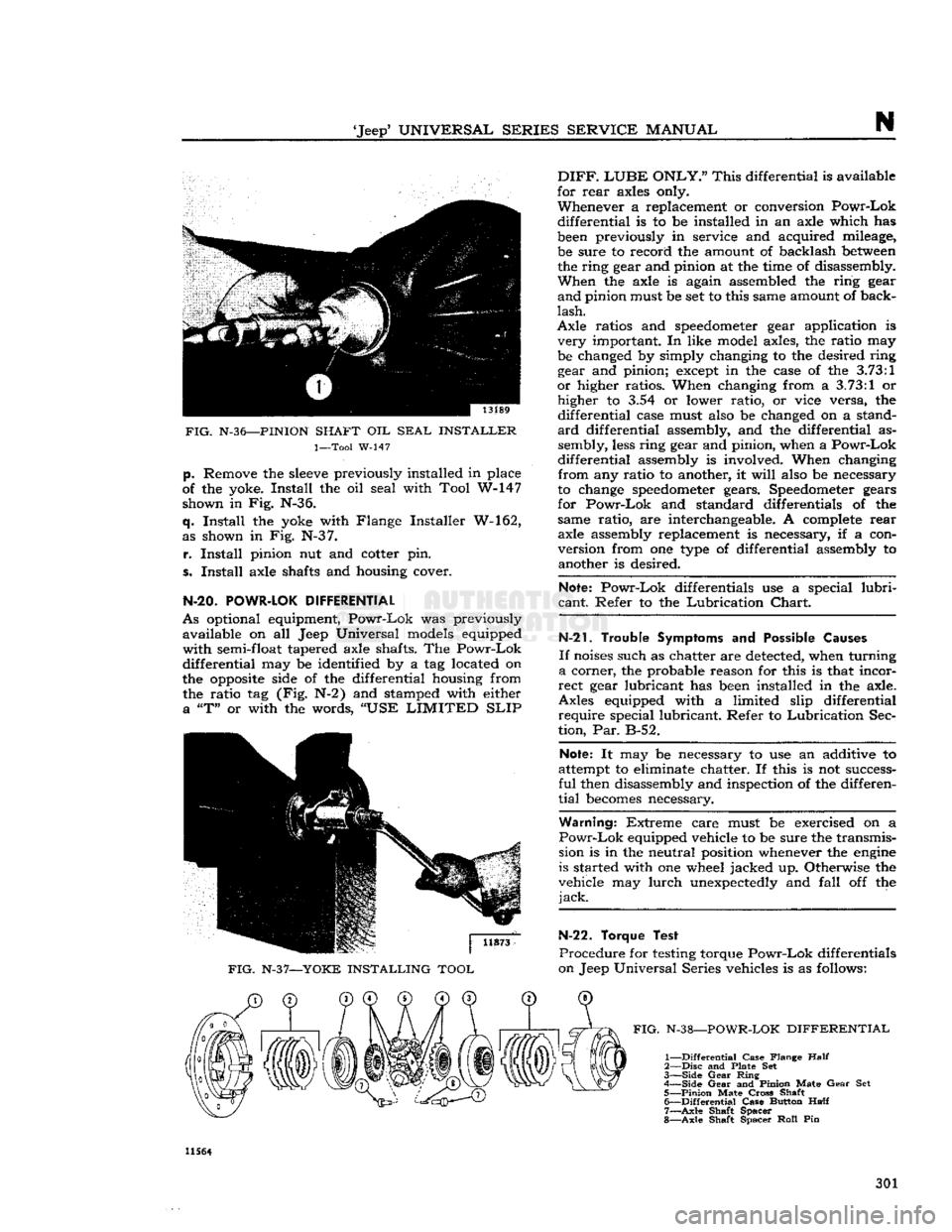
'Jeep'
UNIVERSAL
SERIES SERVICE
MANUAL
N
13189
FIG.
N-36—PINION
SHAFT OIL
SEAL
INSTALLER
1—Tool
W-147
p.
Remove
the
sleeve
previously installed in
place
of
the yoke. Install the oil
seal
with
Tool
W-147 shown in Fig. N-36.
q. Install the yoke
with
Flange
Installer W-162,
as shown in Fig. N-3 7.
r.
Install pinion nut and cotter pin.
s. Install axle
shafts
and housing cover.
N-20.
POWR-LOK
DIFFERENTIAL
As
optional equipment, Powr-Lok was previously available on all
Jeep
Universal
models
equipped
with
semi-float
tapered
axle
shafts.
The Powr-Lok
differential
may be identified by a tag located on
the opposite
side
of the differential housing
from
the ratio tag (Fig. N-2) and
stamped
with
either a "T" or
with
the words, "USE
LIMITED
SLIP
FIG.
N-37—YOKE INSTALLING TOOL
DIFF.
LUBE
ONLY."
This differential is available
for
rear
axles
only.
Whenever a
replacement
or conversion Powr-Lok
differential
is to be installed in an axle which has
been
previously in
service
and acquired mileage, be
sure
to record the amount of backlash
between
the ring
gear
and pinion at the time of
disassembly.
When the axle is again
assembled
the ring
gear
and pinion must be set to this
same
amount of
back
lash.
Axle
ratios and
speedometer
gear
application is very important. In
like
model
axles,
the ratio may
be
changed
by simply changing to the desired ring
gear
and pinion;
except
in the
case
of the
3.73:1
or higher ratios. When changing
from
a
3.73:1
or higher to 3.54 or lower ratio, or vice
versa,
the
differential
case
must
also
be
changed
on a
stand
ard differential
assembly,
and the differential as sembly,
less
ring
gear
and pinion, when a Powr-Lok
differential
assembly
is involved. When changing
from
any ratio to
another,
it
will
also
be
necessary
to
change
speedometer
gears.
Speedometer
gears
for
Powr-Lok and
standard
differentials of the
same
ratio, are
interchangeable.
A complete
rear
axle
assembly
replacement
is
necessary,
if a con
version
from
one type of differential
assembly
to
another
is desired.
Note: Powr-Lok differentials use a special
lubri
cant.
Refer to the Lubrication Chart.
N-21.
Trouble Symptoms and
Possible
Causes
If
noises
such
as
chatter
are
detected,
when turning
a corner, the probable
reason
for this is that incor
rect
gear
lubricant has
been
installed in the axle.
Axles
equipped
with
a
limited
slip differential require special lubricant. Refer to Lubrication
Sec
tion,
Par. B-52.
Note: It may be
necessary
to use an additive to
attempt to eliminate
chatter.
If this is not
success
ful
then
disassembly
and inspection of the differen
tial
becomes
necessary.
Warning:
Extreme
care
must be exercised on a
Powr-Lok
equipped vehicle to be
sure
the transmis
sion is in the neutral position
whenever
the
engine
is
started
with
one wheel jacked up. Otherwise the
vehicle may lurch unexpectedly and
fall
off the
jack.
N-22. Torque Test
Procedure
for testing torque Powr-Lok differentials
on
Jeep
Universal
Series
vehicles is as follows:
FIG.
N-38—POWR-LOK DIFFERENTIAL
1—
Differential
Case Flange
Half
2—
Disc
and Plate Set
3—
Side
Gear
Ring
4— Side
Gear
and Pinion Mate
Gear
Set
5—
Pinion
Mate
Cross
Shaft 6—
Differential
Case Button
Half
7—
Axle
Shaft Spacer
8—
Axle
Shaft Spacer
Roll
Pin 11564
301
Page 303 of 376
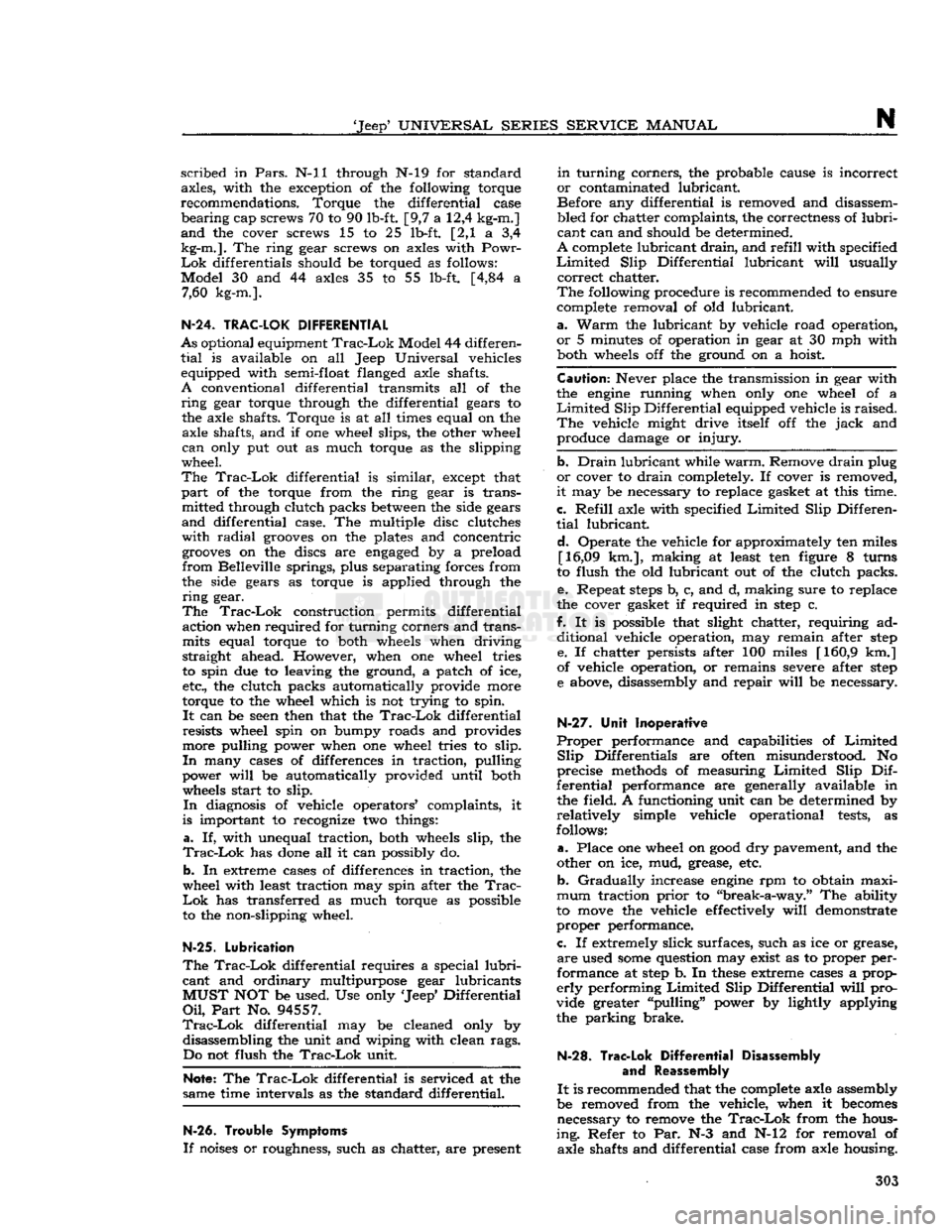
'Jeep*
UNIVERSAL
SERIES SERVICE
MANUAL
N
scribed
in
Pars.
N-ll through N-l9 for standard
axles, with the exception of the following torque
recommendations. Torque the differential case
bearing
cap screws 70 to 90 lb-ft. [9,7 a 12,4 kg-m.]
and
the cover screws 15 to 25 lb-ft. [2,1 a 3,4
kg-m.].
The ring gear screws on axles with Powr-
Lok
differentials should be torqued as follows:
Model
30 and 44 axles 35 to 55 lb-ft. [4,84 a 7,60 kg-m.].
N-24. TRAC-LOK DIFFERENTIAL
As
optional equipment
Trac-Lok
Model 44 differen
tial
is available on all Jeep Universal vehicles equipped with semi-float flanged axle shafts.
A
conventional differential transmits all of the
ring
gear torque through the differential gears to the axle shafts. Torque is at all
times
equal on the axle shafts, and if one wheel slips, the other wheel
can
only put out as much torque as the slipping
wheel.
The
Trac-Lok
differential is similar,
except
that
part
of the torque from the ring gear is trans mitted through clutch packs
between
the side gears
and
differential case. The multiple disc clutches
with
radial
grooves
on the plates and concentric
grooves
on the discs are
engaged
by a preload
from
Belleville springs, plus separating forces from
the side gears as torque is applied through the
ring
gear.
The
Trac-Lok
construction permits differential action when required for turning corners and transmits equal torque to both
wheels
when driving
straight
ahead. However, when one wheel tries to spin due to leaving the ground, a patch of ice,
etc., the clutch packs automatically provide more
torque to the wheel which is not trying to spin.
It
can be
seen
then that the
Trac-Lok
differential
resists wheel spin on bumpy roads and provides
more pulling power when one wheel tries to slip.
In
many cases of differences in traction, pulling
power
will
be automatically provided until both
wheels
start to slip.
In
diagnosis of vehicle operators' complaints, it
is important to recognize two things:
a.
If, with unequal traction, both
wheels
slip, the
Trac-Lok
has
done
all it can possibly do.
b.
In extreme cases of differences in traction, the
wheel with least traction may spin after the
Trac-
Lok
has transferred as much torque as possible
to the non-slipping wheel.
N-25.
Lubrication
The
Trac-Lok
differential requires a special
lubri
cant
and ordinary multipurpose gear lubricants
MUST
NOT be used. Use only 'Jeep* Differential
Oil,
Part
No. 94557.
Trac-Lok
differential may be cleaned only by disassembling the unit and wiping with clean rags. Do not flush the
Trac-Lok
unit.
Note:
The
Trac-Lok
differential is serviced at the
same time intervals as the standard differential.
N-26.
Trouble
Symptoms
If
noises
or roughness, such as chatter, are present
in
turning corners, the probable cause is incorrect
or
contaminated lubricant.
Before any differential is removed and disassem
bled for chatter complaints, the correctness of
lubri
cant
can and should be determined.
A
complete
lubricant
drain,
and
refill
with specified
Limited
Slip Differential lubricant
will
usually
correct
chatter.
The
following procedure is recommended to ensure
complete
removal of old lubricant.
a.
Warm
the lubricant by vehicle road operation,
or
5 minutes of operation in gear at 30 mph with
both
wheels
off the ground on a hoist.
Caution:
Never place the transmission in gear with
the
engine
running when only one wheel of a
Limited
Slip Differential equipped vehicle is raised.
The
vehicle might drive itself off the
jack
and produce damage or
injury.
b.
Drain
lubricant while
warm.
Remove
drain
plug
or
cover to
drain
completely. If cover is removed,
it
may be necessary to replace gasket at this time.
c.
Refill
axle with specified
Limited
Slip Differen
tial
lubricant.
d.
Operate the vehicle for approximately ten miles
[16,09
km.], making at least ten figure 8 turns
to flush the old lubricant out of the clutch packs.
e.
Repeat
steps
b, c, and d, making sure to replace
the cover gasket if required in
step
c.
f. It is possible that slight chatter, requiring ad
ditional
vehicle operation, may remain after
step
e. If chatter persists after 100 miles
[160,9
km.]
of vehicle operation, or remains severe after
step
e above, disassembly and repair
will
be necessary.
N-27.
Unit
Inoperative
Proper
performance and capabilities of
Limited
Slip
Differentials are
often
misunderstood. No
precise
methods
of measuring
Limited
Slip Dif
ferential
performance are generally available in the field. A functioning unit can be determined by
relatively
simple vehicle operational
tests,
as
follows:
a.
Place one wheel on
good
dry pavement, and the
other on ice, mud, grease, etc.
b.
Gradually
increase
engine
rpm to obtain maxi
mum
traction
prior
to "break-a-way." The ability
to
move
the vehicle
effectively
will
demonstrate
proper
performance.
c.
If extremely slick surfaces, such as ice or grease,
are
used
some
question may exist as to proper per
formance at
step
b. In
these
extreme cases a prop
erly
performing
Limited
Slip Differential
will
pro
vide greater "pulling" power by lightly applying
the parking brake.
N-23.
Trac-Lok
Differential Disassembly
and
Reassembly
It
is recommended that the
complete
axle assembly
be removed from the vehicle, when it
becomes
necessary to remove the
Trac-Lok
from the hous
ing.
Refer to Par. N-3 and N-12 for removal of axle shafts and differential case from axle housing. 303
Page 316 of 376
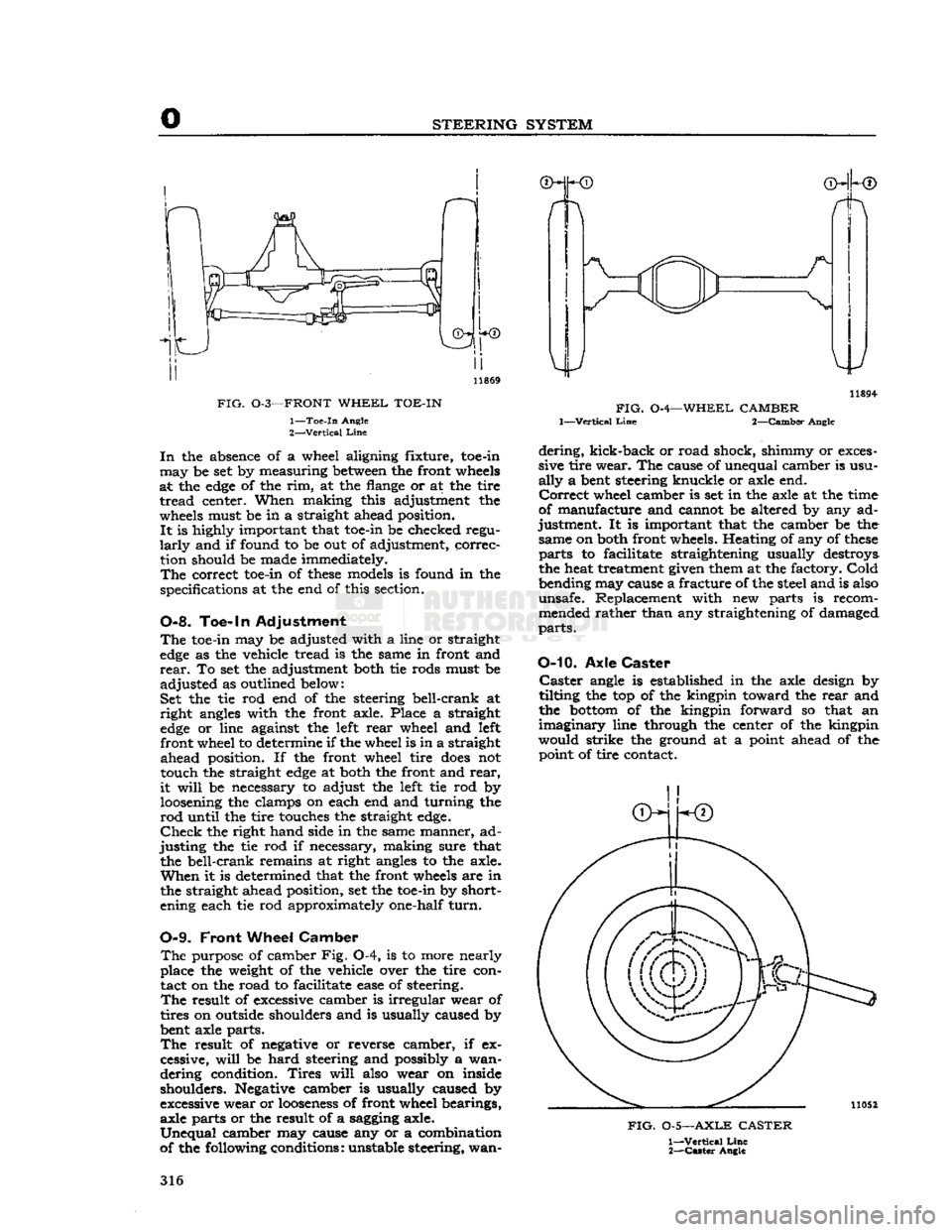
o
STEERING SYSTEM
FIG.
0-3—FRONT
WHEEL
TOE-IN
1—
Toe-in
Angle
2—
Vertical
Line
In
the absence of a wheel aligning fixture, toe-in
may
be set by measuring
between
the front wheels
at the
edge
of the rim, at the flange or at the tire
tread
center. When making this adjustment the
wheels must be in a straight ahead position.
It
is highly important that toe-in be checked regu
larly
and if found to be out of adjustment, correc tion should be made immediately.
The
correct toe-in of
these
models is found in the
specifications at the end of this section.
0-8. Toe-in Adjustment
The
toe-in may be adjusted with a line or straight
edge
as the vehicle tread is the same in front and
rear.
To set the adjustment both tie rods must be
adjusted
as outlined below:
Set the tie rod end of the steering bell-crank at
right
angles with the front axle. Place a straight
edge
or line against the left
rear
wheel and left front wheel to determine if the wheel is in a straight
ahead
position. If the front wheel tire
does
not touch the straight
edge
at both the front and
rear,
it
will
be necessary to adjust the left tie rod by loosening the clamps on each end and turning the
rod
until the tire touches the straight
edge.
Check
the right hand side in the same manner, ad
justing
the tie rod if necessary, making sure that the bell-crank remains at right angles to the axle.
When
it is determined that the front wheels are in the straight ahead position, set the toe-in by short
ening each tie rod approximately one-half
turn.
0-9.
Front
Wheel
Camber
The
purpose of camber Fig. 0-4, is to more nearly
place the weight of the vehicle over the tire con tact on the road to facilitate
ease
of steering.
The
result of excessive camber is irregular wear of
tires on outside shoulders and is usually caused by
bent axle parts.
The
result of negative or reverse camber, if ex
cessive,
will
be
hard
steering and possibly a wan
dering
condition.
Tires
will
also wear on inside shoulders. Negative camber is usually caused by
excessive wear or
looseness
of front wheel bearings, axle parts or the result of a sagging axle.
Unequal
camber may cause any or a combination
of the following conditions: unstable steering, wan- 11894-
FIG.
0-4—WHEEL CAMBER
1—Vertical
Line
2—Camber Angle
dering,
kick-back or road shock, shimmy or exces
sive tire wear. The cause of unequal camber is usu
ally
a bent steering knuckle or axle end.
Correct
wheel camber is set in the axle at the time
of manufacture and cannot be altered by any ad
justment. It is important that the camber be the same on both front wheels. Heating of any of
these
parts
to facilitate straightening usually destroys
the heat treatment given them at the factory.
Cold
bending may cause a fracture of the steel and is also
unsafe. Replacement with new parts is recom mended rather than any straightening of damaged
parts.
O-10.
Axle
Caster Caster
angle is established in the axle design by
tilting the top of the kingpin toward the
rear
and
the
bottom
of the kingpin forward so that an
imaginary
line through the center of the kingpin
would strike the ground at a point ahead of the point of tire contact.
FIG.
0-5—AXLE
CASTER
1—
Vertical
Line
2—
Caster
Angle
316
Page 318 of 376
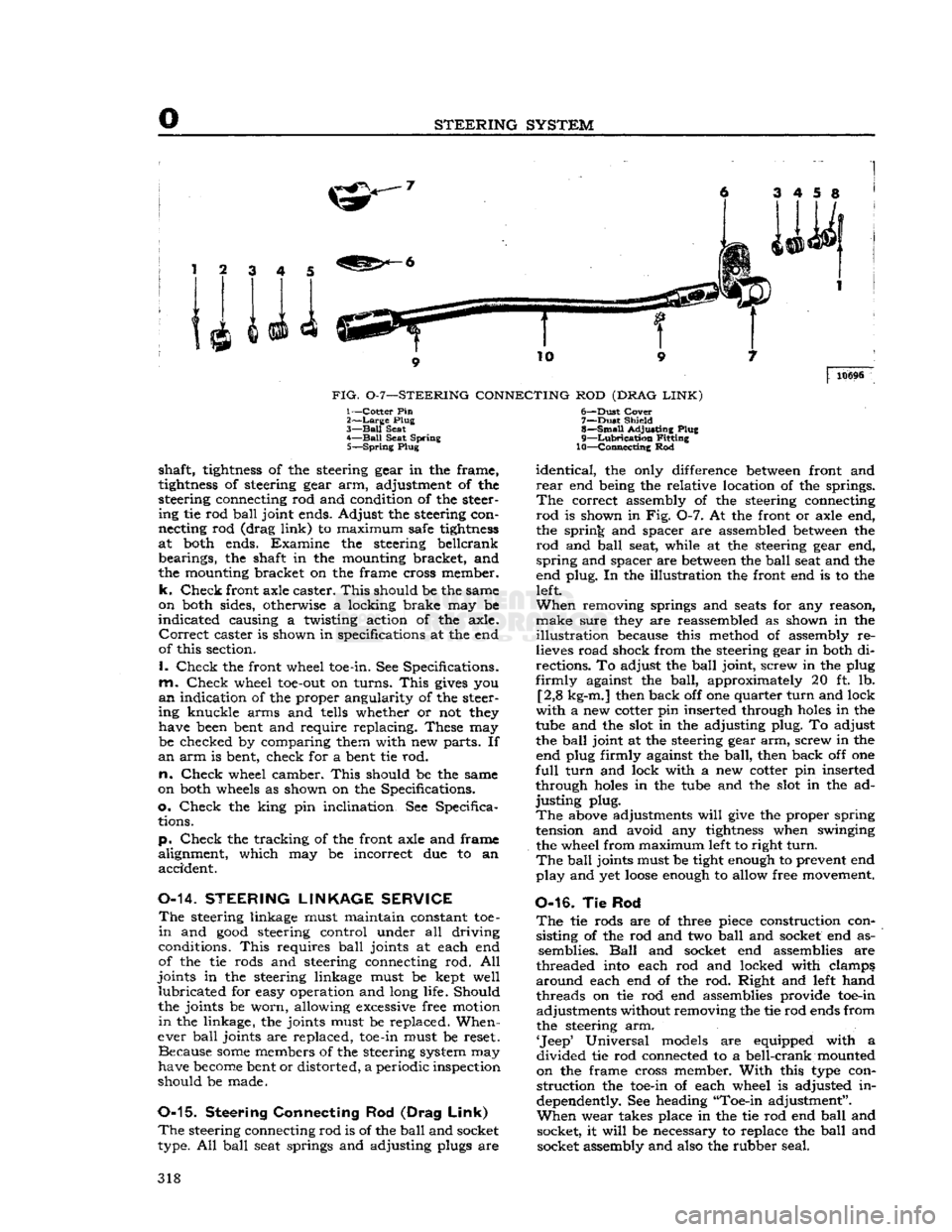
o
STEERING
SYSTEM
10
FIG.
0-7—STEERING
CONNECTING
ROD
(DRAG
LINK)
10696
1—Cotter Pin
2>—Large
Plug
3—
Ball
Seat
4—
Ball
Seat Spring 5—
Spring
Plug
shaft,
tightness
of the steering gear in the frame,
tightness
of steering gear arm, adjustment of the
steering connecting rod and condition of the steer ing tie rod
ball
joint ends. Adjust the steering con
necting rod (drag
link)
to maximum safe
tightness
at both ends. Examine the steering beilcrank bearings, the shaft in the mounting bracket, and
the mounting bracket on the frame cross member,
k.
Check
front axle caster.
This
should be the same
on both sides, otherwise a locking brake may be
indicated
causing a twisting action of the axle.
Correct
caster is shown in specifications at the end
of this section.
I.
Check
the front wheel toe-in. See Specifications,
m.
Check
wheel
toe-out
on turns.
This
gives
you
an
indication of the proper angularity of the steer
ing knuckle arms and tells whether or not they have been bent and require replacing. These may be checked by comparing them with new parts. If
an
arm is bent, check for a bent tie rod.
n.
Check
wheel camber.
This
should be the same
on both wheels as shown on the Specifications,
o.
Check
the king pin inclination. See Specifica tions.
p.
Check
the tracking of the front axle and frame
alignment, which may be incorrect due to an accident.
0-14.
STEERING
LINKAGE
SERVICE
The
steering linkage must maintain constant toe-
in
and
good
steering control under all driving
conditions.
This
requires
ball
joints at each end
of the tie rods and steering connecting rod. All
joints in the steering linkage must be kept well
lubricated
for easy operation and long life. Should
the joints be worn, allowing excessive free motion
in
the linkage, the joints must be replaced. When
ever
ball
joints are replaced, toe-in must be reset. Because
some
members of the steering system may
have
become
bent or distorted, a periodic inspection
should be made.
0-15.
Steering Connecting
Rod
(Drag
Link)
The
steering connecting rod is of the
ball
and socket
type. All
ball
seat springs and adjusting plugs are 6—
-Dust
Cover
7—
Dust
Shield
8—
Small
Adjusting Plug
9—
Lubrication
Fitting
10—Connecting Rod
identical,
the only difference
between
front and
rear
end being the relative location of the springs.
The
correct assembly of the steering connecting
rod
is shown in Fig. 0-7. At the front or axle end,
the spring and spacer are assembled
between
the
rod
and
ball
seat, while at the steering gear end,
spring
and spacer are
between
the
ball
seat and the
end plug. In the illustration the front end is to the left.
When
removing springs and
seats
for any reason,
make
sure they are reassembled as shown in the
illustration
because this method of assembly re
lieves road shock from the steering gear in both di
rections. To adjust the
ball
joint, screw in the plug
firmly
against the
ball,
approximately 20 ft. lb. [2,8 kg-m.] then back off one quarter
turn
and lock
with
a new cotter pin inserted through
holes
in the
tube and the slot in the adjusting plug. To adjust the
ball
joint at the steering gear arm, screw in the end plug firmly against the
ball,
then back off one
full
turn
and lock with a new cotter pin inserted
through
holes
in the tube and the slot in the ad
justing
plug.
The
above adjustments
will
give
the proper spring
tension and avoid any
tightness
when swinging
the wheel from maximum left to right
turn.
The
ball
joints must be tight enough to prevent end
play
and yet
loose
enough to allow free movement.
0-16. Tie Rod
The
tie rods are of three piece construction consisting of the rod and two
ball
and socket end as semblies.
Ball
and socket end assemblies are
threaded into each rod and locked with clamps,
around
each end of the rod. Right and left hand threads on tie rod end assemblies provide toe-in adjustments without removing the tie rod ends from
the steering arm.
'Jeep'
Universal models are equipped with a
divided
tie rod connected to a bell-crank mounted
on the frame cross member.
With
this type con
struction
the toe-in of each wheel is adjusted in
dependently. See heading "Toe-in adjustment".
When
wear takes place in the tie rod end
ball
and socket, it
will
be necessary to replace the
ball
and socket assembly and also the rubber seal. 318
Page 323 of 376
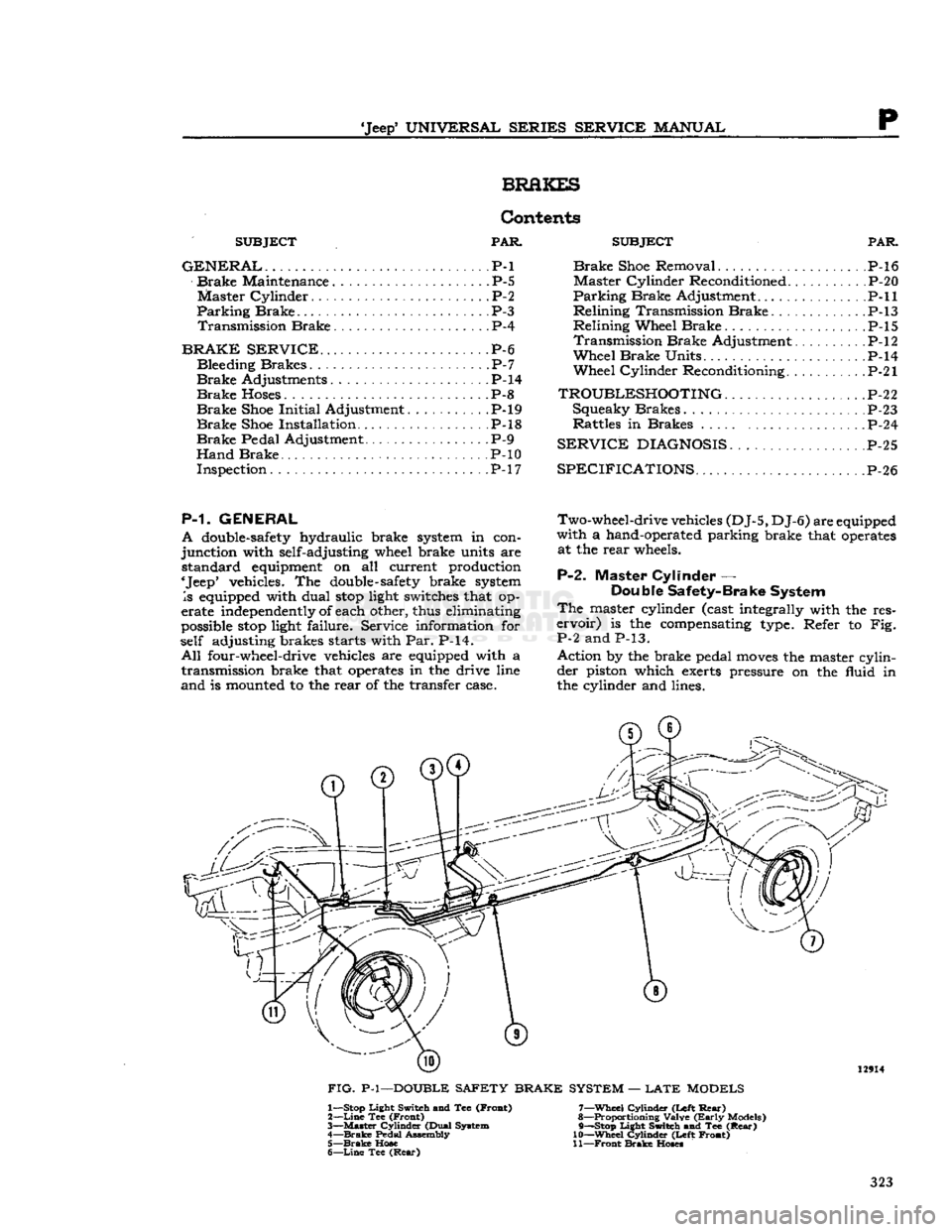
'Jeep'
UNIVERSAL
SERIES SERVICE
MANUAL
P
BRAKES
SUBJECT
PAR
GENERAL.
. P-l
Brake
Maintenance P-5
Master
Cylinder.
P-2
Parking
Brake
P-3
Transmission
Brake
P-4
BRAKE SERVICE
.P-6 Bleeding Brakes P-7
Brake
Adjustments P-14
Brake
Hoses P-8
Brake
Shoe
Initial
Adjustment P-l9
Brake
Shoe Installation P-l8
Brake
Pedal Adjustment P-9
Hand
Brake.
P-10 Inspection P-17
SUBJECT
PAR
Brake
Shoe Removal P-l6
Master
Cylinder Reconditioned. . P-20
Parking
Brake
Adjustment
.P-l 1
Relining
Transmission
Brake
P-13
Relining
Wheel
Brake
P-l5
Transmission
Brake
Adjustment .P-12
Wheel
Brake
Units P-14
Wheel
Cylinder Reconditioning P-21
TROUBLESHOOTING
P-2 2 Squeaky Brakes P-23
Rattles in Brakes P-24
SERVICE
DIAGNOSIS.
P-25
SPECIFICATIONS
P-2 6
P-1. GENERAL
A
double-safety
hydraulic brake system in con
junction with self-adjusting wheel brake units are
standard
equipment on all current production
'Jeep* vehicles. The
double-safety
brake system
Is
equipped with dual
stop
light switches that op
erate independently of each other, thus eliminating
possible
stop
light failure. Service information for
self adjusting brakes starts with Par. P-14.
All
four-wheel-drive vehicles are equipped with a transmission brake that operates in the drive line
and
is mounted to the rear of the transfer case. Two-wheel-drive vehicles
(DJ-5,
DJ-6)
are equipped
with a hand-operated parking brake that operates at the rear wheels.
P-2.
Master Cylinder —
Double Safety-Brake System
The
master cylinder (cast integrally with the res
ervoir)
is the compensating type. Refer to Fig.
P-2 and P-13.
Action by the brake pedal
moves
the master cylinder piston which exerts pressure on the fluid in
the cylinder and lines. 12914
FIG.
P-l—DOUBLE SAFETY BRAKE SYSTEM —
LATE
MODELS 1— Stop Light Switch and Tee (Froat)
2—
Line
Tee (Front)
3—
Master
Cylinder (Dual System
4—
Brake
Pedal Assembly 5—
Brake
Hose
6—
Line
Tee
(Rear)
7—
Wheel
Cylinder (Left
Rear)
8— Proportioning Valve
(Early
Models)
9— —Stop Light Switch and Tee
(Rear)
10—
Wheel
Cylinder (Left Front)
11—
Front
Brake
Hoses
323